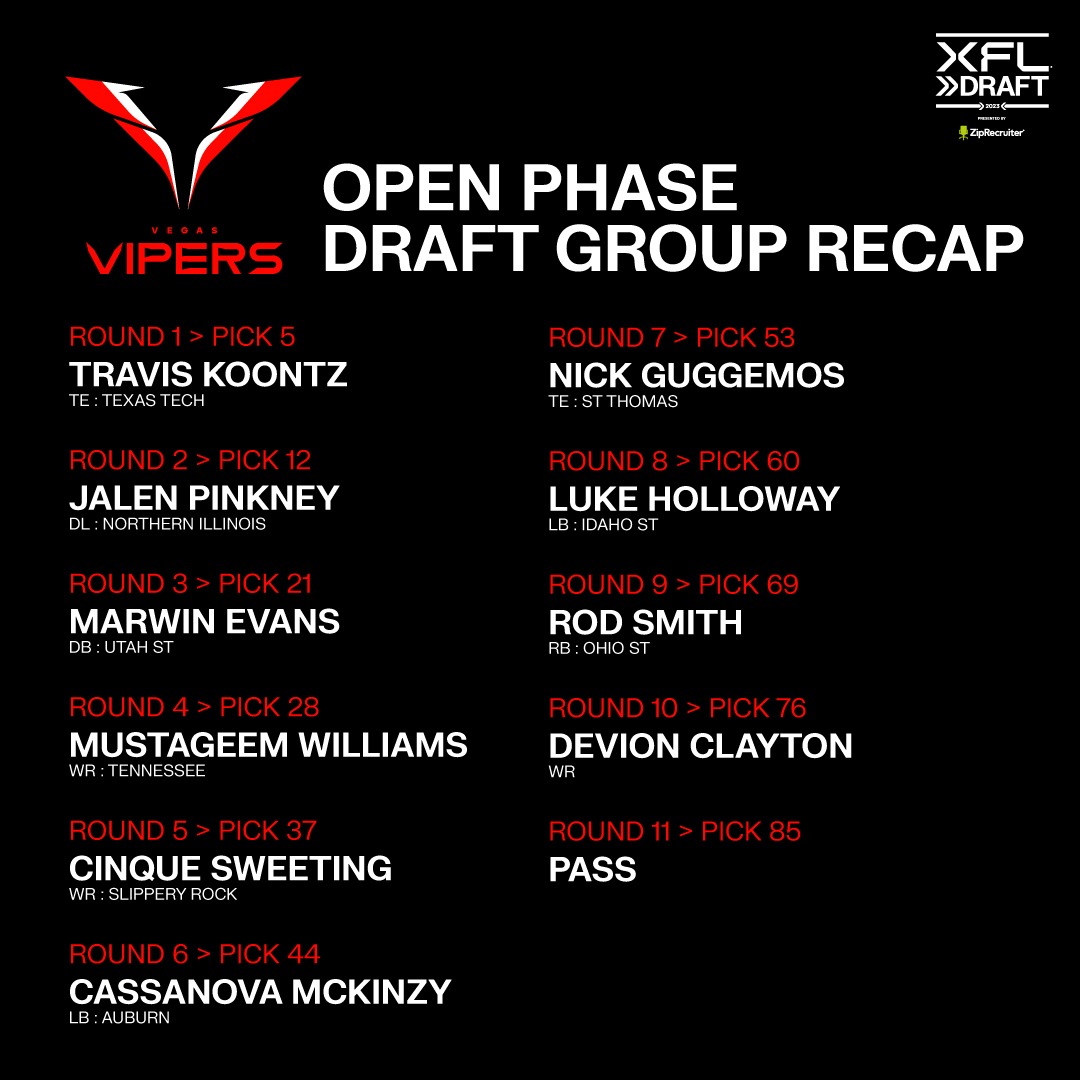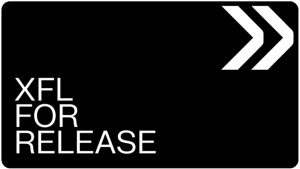In preparation for the upcoming XFL Rookie Draft, I’m reflecting back on the first draft, held last November, where teams began to build their rosters. This is the final part, part five, analyzing the Open Phase. Here are links to the previous phases:
Skill Position Phase | Offensive Line Phase | Defensive Front Seven Phase | Defensive Backs Phase
Draft analysis and rankings are ultimately subjective, but to add a little but more objectivity to the exercise, I decided to rank each team by the number of snaps played by draftees of that team in that particular phase. Obviously not all snaps are created equal, but I do think this pretty accurately reflects how well each team did.
1. Vegas Vipers (1,181 snaps)
Yup, that makes three in a row for Vegas at the number one spot. TE Travis Koontz, their first Open Phase selection, was fourth-string at the position throughout the year, playing about 10 snaps per game on offense. He did play extensively on special teams. S Marwin Evans and WR Cinque Sweeting were two other key players taken in this phase. Like Koontz, Sweeting was a factor on special teams. With their penultimate pick, Vegas chose what was to become their starting RB in Rod Smith. Depending on your point of view, Vegas either did really well in finding gems in this phase, or the fact that they needed to rely so heavily on players passed over in their positional phases is part of the story that led to the Vipers’ 2-8 record in 2023.
2. Seattle Sea Dragons (1,078 snaps)
Seattle and Vegas were the only teams to reach the 1,000-snap plateau with their Open Phase selections. G Josh Seltzner was the first Open pick and while he didn’t start, he played from scrimmage in nine games as Seattle liked to rotate their linemen in and out of the lineup. DT Sama Paama was another player for whom the “Player 54” show profiled, as he gave up his remaining college eligibility to play for Seattle. He’s still extremely raw. WR Blake Jackson became a favorite target of Ben DiNucci’s, finishing second on the team in receiving. In round 11, the team chose RB Morgan Ellison. Ellison averaged 4.9 yards per carry while thrust into starting duty when Brenden Knox got hurt. However, Ellison ended up being felled by an injury halfway through the season, forcing the Sea Dragons to patch together a backfield for the remainder of the year.
3. St. Louis Battlehawks (908 snaps)

All three wide receivers taken in the Open Phase by St. Louis carved out roles for the team in 2023. The earliest pick, George Campbell, saw the least amount of playing time, as both Steven Mitchell, Jr. and Gary Jennings played over him. RB Leddie Brown ended up thriving, but as De’Veon Smith’s backup in Arlington. TE Jake Sutherland, DT Tani Tupou and LB Silas Kelly all made the team and stayed on the roster for the duration of the season. The Battlehawks did well to add depth and special teams contributors in this Phase.
4. San Antonio Brahmas (903 snaps)
The first pick in the Open Phase by San Antonio was hulking DT Matthew Gotel, who ended up starting nine of 10 games. DL Julian McLeod suffered an injury in training camp and was placed on IR, then later released. WR Landen Akers turned out to be San Antonio’s most consistent receiving threat. Fourth round DB Stephen Denmark also ended up on IR. LB Ben Davis, a rookie, worked his way into the defensive rotation. And RB Jon Hilliman managed to give Jacques Patrick a breather in the offensive backfield. San Antonio took just eight players, while most others chose nine or more, making their appearance in the top half here all the more impressive.
5. Arlington Renegades (883 snaps)
More than half of their snaps in this phase came from S Joe Powell, who was selected with an eighth round pick. First round WR Sean Modster initially made the team, but was released in mid-March as Arlington searched for solutions to their lack of offense. Those solutions included turning over their receiver room. LB Edmond Robinson was limited to four regular season games due to injury. RB Kenneth Farrow was brought back after being cut in training camp, replacing Keith Ford at the backup spot after Ford was let go. Farrow too was injured and announced his retirement after the season. He was joined in retirement by DT TJ Barnes, who played a major role in the defensive line rotation all year.
6. Houston Roughnecks (879 snaps)
Houston used all 11 available choices in this round, one of only two teams to do so. Clearly, they didn’t get much out of their quantity. Second round pick LB Duke Ejiofor was injured in the first game and didn’t see the field the rest of the season. WR Travell Harris vaulted into a starting spot, while fellow receiver Ben Putman played a reserve role. DT Trevon Mason was another starter Houston developed out of this phase. None of the final six picks made the team.
7. Orlando Guardians (496 snaps)
Orlando got even less mileage out of its 11 selections than Houston did. Most of the work was done by the linebackers: Jeremiah Gemmel, Lakia Henry, and Erroll Thompson, the first three picks, all filled out the LB depth chart for the Guardians. CB Justin Rogers was the team’s main punt returner, but didn’t see much of the field on defense. RB Kelvin Taylor fared well in limited carries early in the season, but once Devin Darrington returned from injured reserve, Taylor was jettisoned.
8. DC Defenders (61 snaps)
DC chose the fewest players and had by far the fewest snaps out of this phase – in fact, 60 out of 61 of the snaps came from CB KJ Sails, who was taken with the seventh and final pick of this phase. Who had the distinction of taking the other, single snap from this phase? That would be RB Artavis Pierce, who was eventually put on injured reserve. He joined DE Jesse Aniebonam there. The Defenders traded their first pick in the phase, WR Zimari Manning, to the Renegades for DB Cameron Lewis. Manning didn’t end up making Arlington’s team, but Lewis was able to do so for DC as a deep reserve.
Summary
What follows is a ranking based on adding up the placement of each team in each phase. The lower the score, the better.
- Vegas Vipers – 14
- DC Defenders – 20
- Orlando Guardians – 22
- St. Louis Battlehawks – 23
- Houston Roughnecks – 23
- Seattle Sea Dragons – 24
- San Antonio Brahmas – 26
- Arlington Renegades – 27
Clearly, there’s very little correlation between snaps played from drafted players and the success teams had during the season. There could be a number of reasons for this discrepency: First, it doesn’t take into account the most important position on the field, quarterback, a position that was allocated to teams before and after the draft; second, teams may get a lot of equity from its drafted players, but it doesn’t mean they produced at a high level on the field; and third, it doesn’t take into account preseason and in-season moves, NFLAA assignments, or selections made in the Supplemental Draft, all of which may have significantly improved the quality of the rosters. The one exception to the discrepancy is DC, a team that drafted a lot of players that saw serious playing time, but also constituted quality players based on the fact they made it to the XFL Championship. They were the team that truly mastered the draft.




















